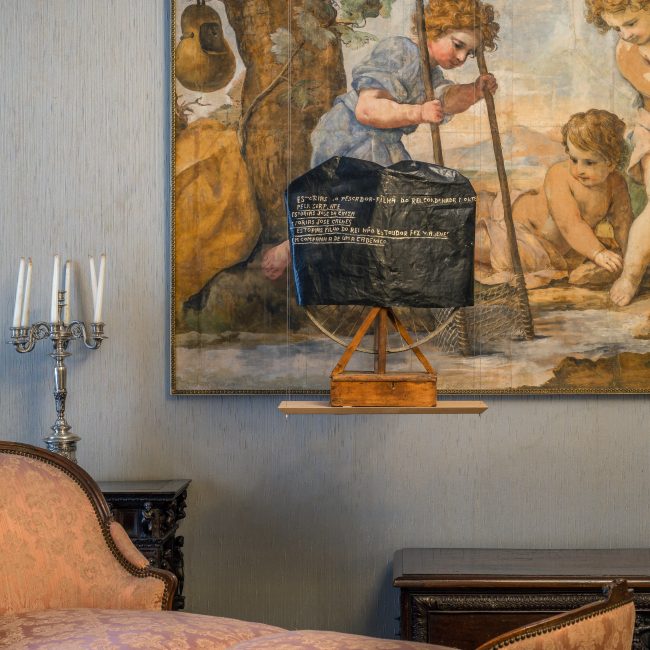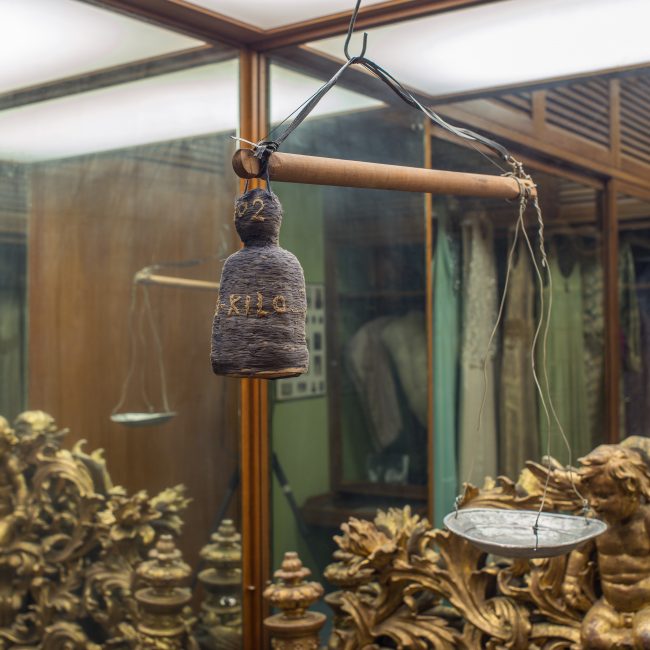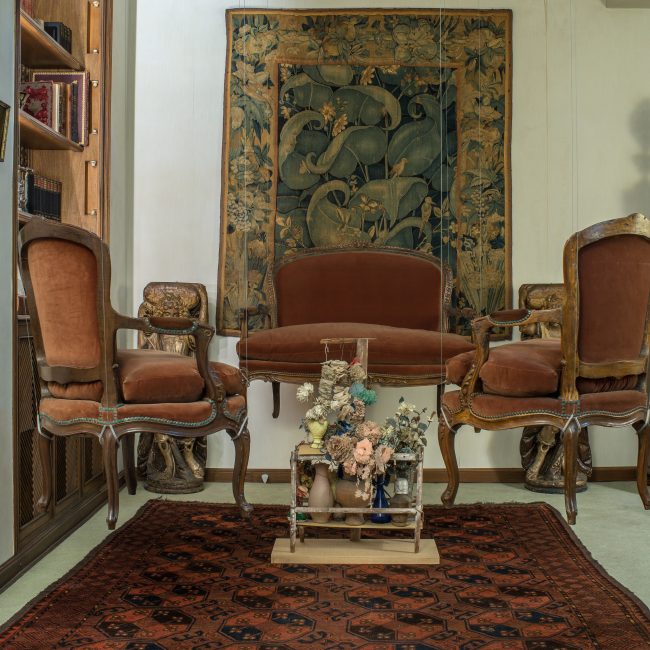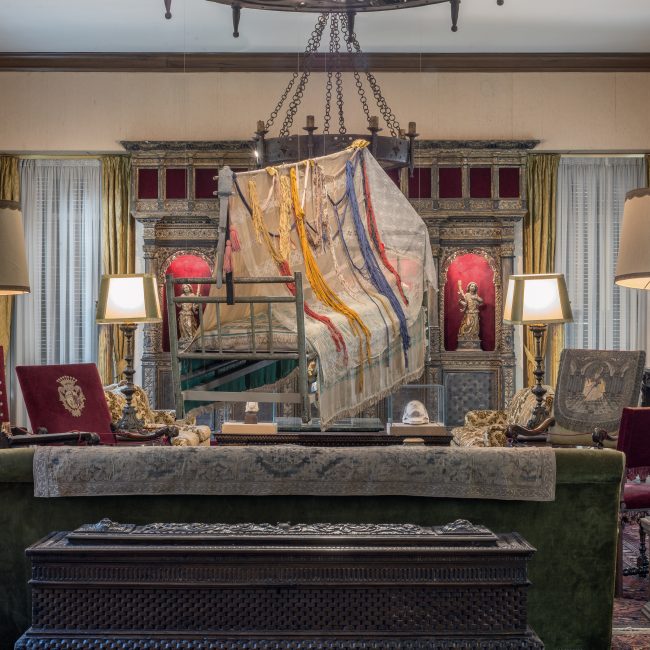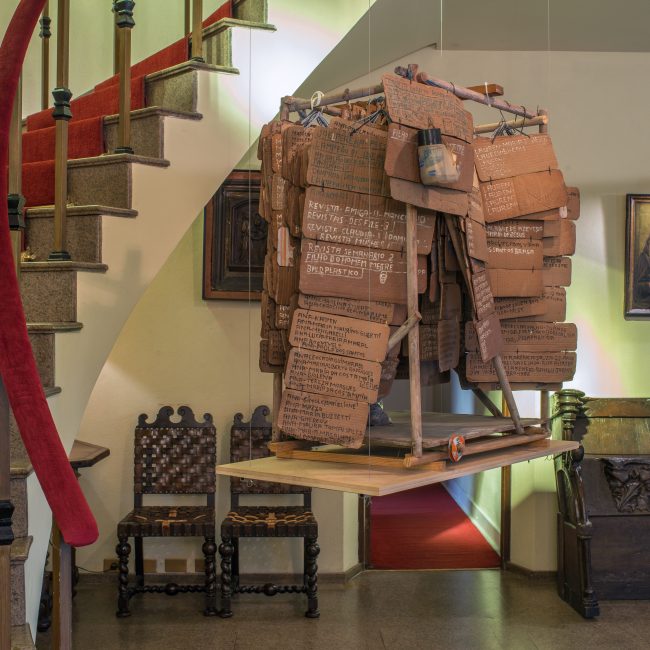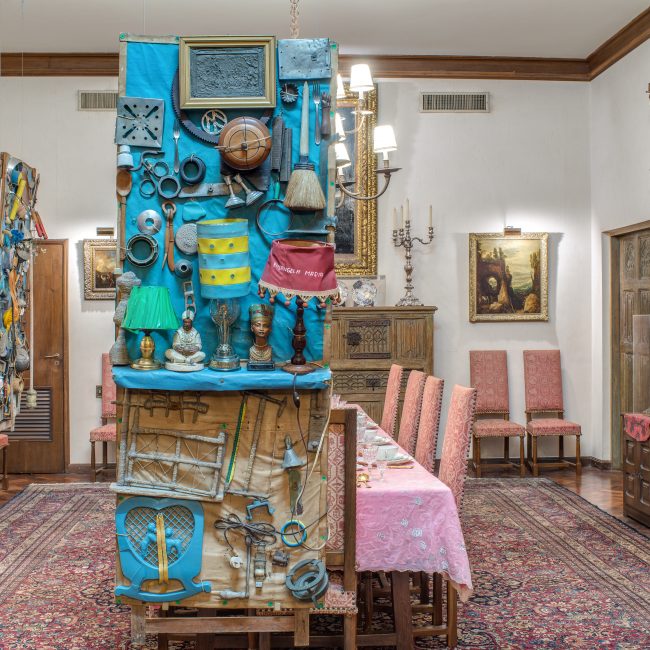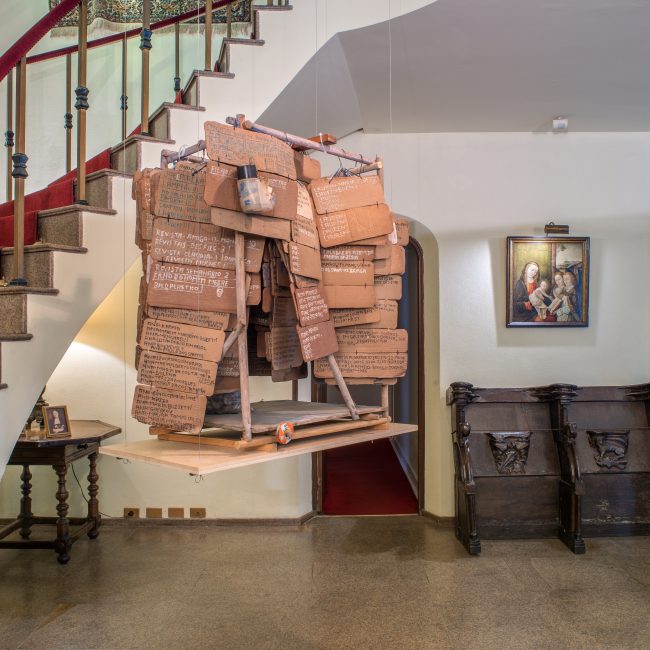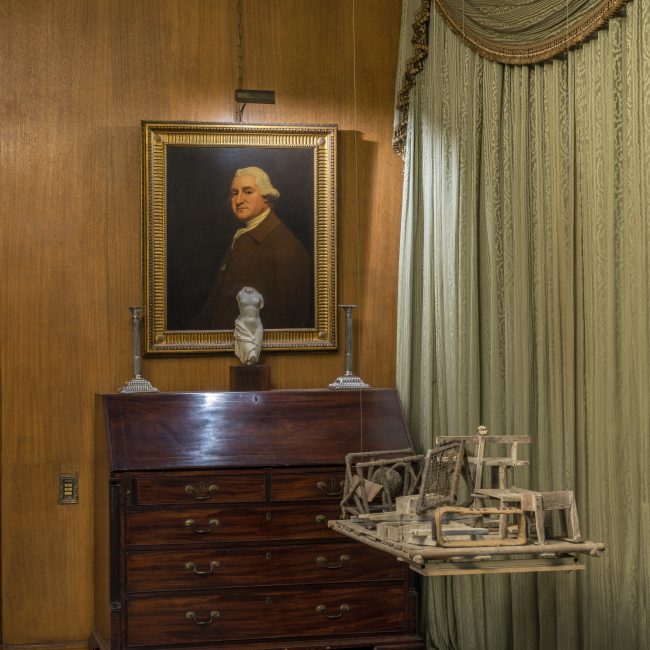Bispo do
Rosário
FLOATING
Breathing Project
22nd edition
september 14 2017 – january 14 2018
Floating
When place becomes time and time becomes place
How hard I find it to move around the territory of Arthur Bispo do Rosário. I feel as if I were mistreating his work. It is hard for a curator to have to admit such a thing, since curatorship is an exercise in partnership. When I am involved with an artwork, it is because I believe I will somehow be able to add something – not to its understanding (because to my mind understanding is not enough, since I do not believe there is anything to be revealed), but to forge a becoming that does not pervert the potency behind the invention of the work and, through my action, may reaffirm its potency. In my view, then, the curator is always dealing with potency. Potency as the urge that germinates not what is explained, but what drives existence on the human plane under the order of the cosmos; pure becoming of invention potency.
The “discomfort” that Bispo do Rosário’s work stirs in me stems from the sense that I am warping the integrity of his work when I break it apart. In a way I feel that by bringing it into the Breathing project I am like an accessory to everything I censure. One day it was decided that it would be better to spread his work around the world. Perhaps as a survival stratagem, for ease of presentation, study, archiving, or apprehension, or for the high cost involved in presenting it all together in touring exhibitions, the decision was made to break apart the way he had combined it in his cell and lived in and with it. It is perhaps down to this fact – or despite it, to paraphrase Merleau-Ponty – that this work has been preserved.[1] But it was certainly also preserved for its potency, its inner coherence, which has come to exercise a kind of gravitational force that, materialized in meaning, kindles immediate recognition and becomes a source of inspiration. His work creates a system of inner saturation that is self-referencing and is the source of its coherence – not from a subjectivity, but a singularity, which offers itself as a channel for expressive meaning through the body/life itself, which thereafter exists only for the expressive needs of the work.
His cell, like the cell of a body, was the minimal unit from which he created the complex body of different “works” (for want of a better word). In fact, they never were, nor are they, individual works, as one may be led to believe by the way they have since been presented; they are, in fact, a whole. They form a cosmos whose totality is not a combination of parts, but an indivisible whole; which is why I speak of the biological cell or even the monad. And it has no artistic pretensions or motivations. It is we (others) who attribute it with such values, since art is everything that has no utility, but which has value to our spirit. Or, to cite Cildo Meireles, “art is always a kind of indispensable inutility arising from those who verge on madness and who have the strength and courage to transform their surroundings.”[2]
Ricardo Aquino writes: “on January 5, 1939, [Arthur Bispo do Rosário], referred from a different asylum, was taken in by the Juliano Moreira Colony, where he was kept in the wing for the agitated. He lived there for a while, left, went back a few times, until in the early 1960s he returned, never to leave again until his death on July 5, 1989: he spent the last twenty-five years of his life in the colony.”[3]
This biographical information is crucial for understanding that at a given point in his life he decided to remain confined, just like Yayoi Kusama years later, cutting himself off from the world in his cell, the territory of his freedom. Bispo do Rosário decided to confine himself, challenging all the clinical procedures of his time (electroconvulsive therapy, lobotomy, etc.) because he became untouchable. What made him untouchable was the coherence of what he was constructing, which they did not understand but which represented a challenge and imposed respect, combined with his physical strength as a former sailor and boxer. He modified his surroundings with the courage of one who bears within himself the certainty of being able to transform his life and environment into what is reserved for him by fate. His cell was the territory of freedom for the future becoming, rid of his past, which was not the memory of disease or nostalgia, but an investment in the potency of life. Where he was sick by the precepts of medicine, he was healthily lucid by the precepts of art. For Foucault, as Ricardo Aquino tells us, “madness is the absence of work,”[4] and “Bispo do Rosário created not through the dynamics of his disease, but those of his life and health. As Deleuze (2004) pointed out, when an artist creates, he heals himself and the world, which is enriched by his creation.”[5]
I believe Tarkovsky can help us develop this idea when he states that art is the spiritual force capable of overcoming the lack of spirituality of a given time – and, I would add, of an individual. Art is capable of detecting the malady of a society or a person caused by a lack of spirituality, but it also has the power to supply the spiritual means to defeat it because it is the potency that allows us to exist in plenitude on the immanent surface of the substance that permeates the world and to feel fully present in the expanded instant of eternity. Art is an encounter with the extended surface that covers everything, where there is no inside or outside, and which breathes life force into us as we are taken over by the liberty of unconstrained creation, where there is neither part nor whole, but each fragment contains the totality: the substantive density of presence.[6] When we are the absence of ourselves and the presence of the world within ourselves.
Bispo do Rosário had a rare capacity to penetrate the realm of subjective dissolvence, giving expression to the words of the world. He realized that the outside is closer than we suppose and there is actually no outside or inside in art. What there is is a continuous contiguity where the individual is the living incarnation of the words of the world. It is a poetic state that few dare or are able to enter, but which many artists strive for. This is a subject that is very tricky to address without being misunderstood or misinterpreted. It is a state of poetic potency where it is possible to experience not the sublime, as in Kant, because it is not an adjectival state, but a radically substantive condition where place becomes time and time becomes place, manifesting the radical experience of the totality of oneness.
This was what led me to consider Arthur Bispo do Rosário’s work as being potentially suitable for interacting with the world of Eva Klabin, but differently from the ways this had been done before in the Breathing project. We are talking here of an artist who is dead: he cannot make an intervention specifically for this house museum. Yet even so the mere mention of the idea elicited an appealing certainty: it set up the enchantment of evidence (what I call substantive affirmation), which is enough of itself, as is the case of everything that is coherent. Yet in theory there could be nothing more incompatible than juxtaposing these two worlds – the worlds of Eva Klabin and Bispo do Rosário.
These two people led diametrically opposing lives. So what is it that conjures up the enchantment of this evidence? There is more that divides than unites them. Which suggests that coherence may not always derive from combining similarities or the banal adage that opposites attract. Their lives were very different, but they both spanned most of the twentieth century. Eva Cecília Klabin was born in 1903 and died in 1991; Arthur Bispo do Rosário was born in 1909 and died in 1989. They were of the same chronological time, but they each lived in completely different worlds; socially, economically, and spiritually they could not have been more different. Yet they were both collectors. Eva put together one of the foremost collections of classical art in Brazil and left it to Rio de Janeiro in recognition of and gratitude for the prosperity her family gained in this country. Bispo do Rosário collected poverty and gathered together everything he came across or was given to make an inventory of the things of the world, to be presented at the time of his death as witness to his passage on this earth. Eva brought together precious objects of society; Bispo do Rosário picked up what was thrown away, worthless, but he knew how to turn into something beyond the disposable. Both were concerned with permanence beyond death and accumulating objects in their dwellings to serve as testaments to their existence.
For me, this is fundamental. In their own particular ways, they both understood the spiritual dimension of existence and wanted to turn the space they created for themselves into materializations of their time: time that became space through them. When we are dislocated in time, we do not just reach another space – we come into the presence of a different time. Spaces are shifts in time. I have always said that the idea behind Breathing was to create shifts in time. The inaugural one was Eva Klabin’s own act of turning her home into a museum. The other shifts (interventions by the guest artists in the Breathing project) are the way I have found to shift the time set fast by Eva Klabin and create new shifts in time that make way for new perceptions of her legacy and thereby ensure its perpetuity.
Meanwhile, Arthur Bispo do Rosário himself created his own shift in time by setting up his cell. The shift he created was cohesive and self-sufficient. I do not think any comparisons would be fitting so as not to give a misleading, superficial sense of similarity. Rather, I would like to demonstrate that both had a commitment to their existence that stemmed from their wishes for permanence and transcendence, which are, however, mutually irreducible. For this very reason, the only way I could combine them in the same space, without reducing them to or imposing them on one another, was to produce the encounter of two spirits: two different ways of being in time. To let the fragments of Bispo do Rosário’s work into Eva Klabin’s world without touching her objects, leaving them as she left them to highlight their differences and herald the encounter of these two dissimilar time spirits that nonetheless belong to the same plural, fragmented, conflicting historical reality.
The suspension – hence, Floating – of the fragments of Bispo do Rosário’s work expresses the curatorial intention to allow them to share the same space as the Eva Klabin collection, respecting their singularities while introducing and putting the spotlight on the work of this artist in the historical pantheon of art for his astoundingly potent insularity. He is a solitary island floating on the ocean of history, carried by the deep undercurrents that form the patterns of the seas, flowing unfettered but not directionless. His work sets its own direction from the potency of art and will not be pinned down, preserving the same deep solitude that the invention of madness reserved for his personal fate by shunning him from society. Bispo do Rosário is a survivor and his work is the expression of the insistence of his survival as a strategy of salvation – both personal and of humankind. He is the living, mindful testament to his time: a collector who kept objects to be presented at his end as redemption for his life and the lives of us all. He understood solitude not as a place for secluded introspection, but where the body renders itself as a channel for duration and thus offers itself to the world as expression through the byways of art. He does not speak of his pain because there is no lamentation. He speaks of bearing witness: of a vibrant, mindful presence of life in whatever form was within his reach, creating a place from the perception of his time life and showing that there is nothing more radical than reality.
Marcio Doctors
[1] I resist the fact that the original set has been fragmented, cherishing the hope that one day it can be presented like Kurt Schwitters’s Merz.
[2] Part of a statement given by Cildo Meireles upon winning the Velázquez Prize, taken from a report in O Estado de S. Paulo newspaper, June 10, 2008.
[3] AQUINO, Ricardo. Do pitoresco ao pontual: uma imagem-biográfica [From the Picturesque to the Pointed: A biographical image]. In: LÁZARO, Wilson (org.). Bispo do Rosário. Rio de Janeiro: Réptil, 2012, p. 49.
[4] Ibid., p. 67.
[5] Idem. Ricardo Aquino’s reference to Deleuze is in: DELEUZE, Gilles. A literatura e a vida [Literature and Life]. In: Crítica e clínica. 1st reprint. São Paulo: 34, 2004, p.13.
[6] This is arguably the only way of perceiving that, despite its fragmentation, his work retains cohesion because each fragment is reminiscent of the whole, so much internal potency does it bear within itself, like a monad.


